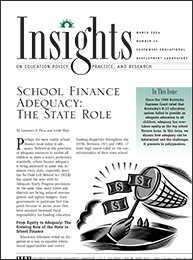At a Glance
Defined as the provision of adequate resources to enable all children to meet a stateÕs proficiency standards, school finance adequacy is being addressed in some way in almost every state. Because states are under increasing pressure to define what constitutes an adequate education and determine how to fund it, this issue of Insights examines the approaches that can be used to determine the cost of an adequate education and discusses recent adequacy studies.
Four approaches that take into account a stateÕs standards and context may be used to determine the cost of an adequate education. All of these approaches link spending and performance:
- Professional judgment approach
- Successful school district approach
- Cost function approach
- Evidence-based approach
None of the four models is predominant; each has certain drawbacks and technical challenges as well as certain advantages. The professional judgment and evidence-based approaches may be advantageous since they may provide a framework for educational strategies that will help states meet performance standards. All of the approaches are likely to result in recommended spending increases for education.
Because adequacy as a standard is still evolving, policymakers will face technical challenges in determining how much an adequate education costs for ÔaverageÕ children and for children with special needs. For this reason, using more than one approach to determine adequacy may be advantageous.
Given tight state budgets, finding a way to pay for the increased funding that adequacy demands may be problematic. For New YorkÕs recent adequacy studies, tremendous time and energy have been devoted to seeking public input with hopes that public involvement will help garner support for the model that emerges.
Whichever adequacy model a stateÕs policymakers choose, continual evaluation is necessary. This will ensure the level of funding remains adequate over time and that the goal of raising student performance is being met.
Next Page: References

